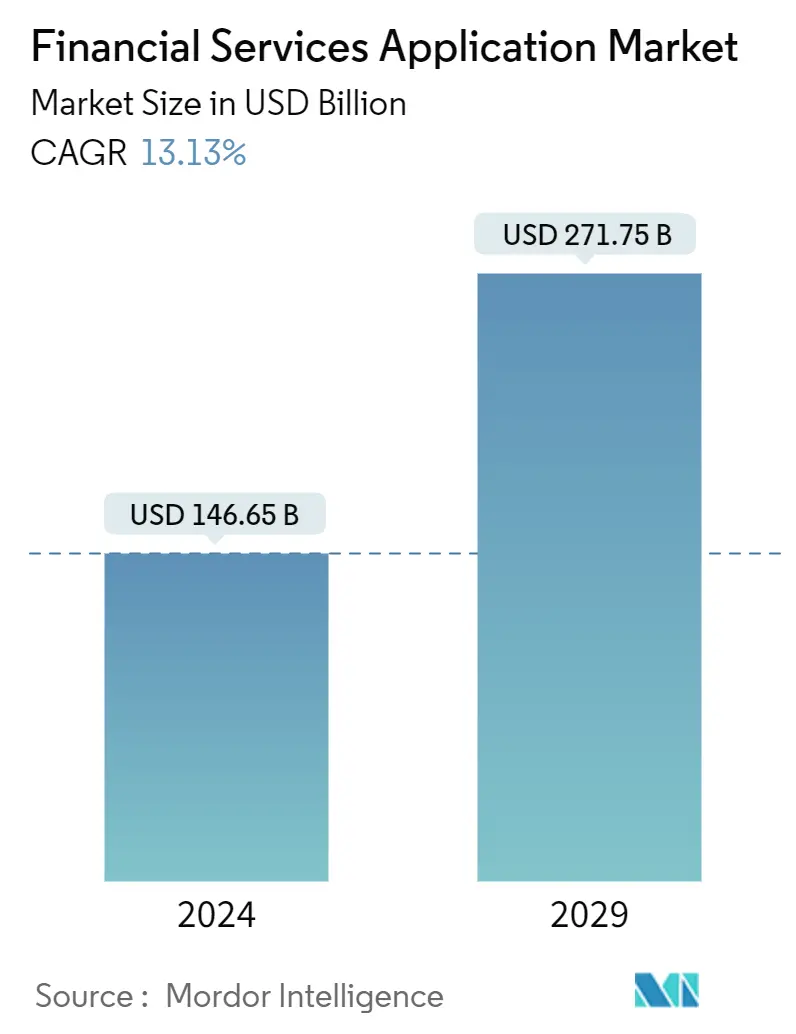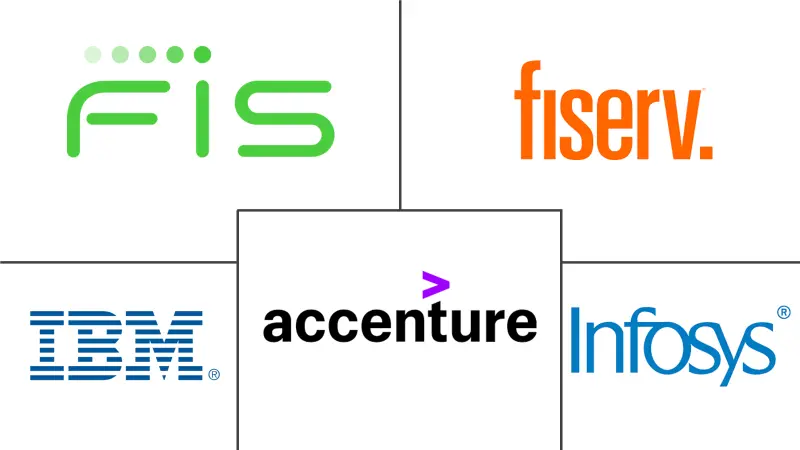Market Size of Financial Services Application Industry

| Study Period | 2019 - 2029 |
| Market Size (2024) | USD 146.65 Billion |
| Market Size (2029) | USD 271.75 Billion |
| CAGR (2024 - 2029) | 13.13 % |
| Fastest Growing Market | Asia Pacific |
| Largest Market | North America |
Major Players
*Disclaimer: Major Players sorted in no particular order |
Financial Services Applications Market Analysis
The Financial Services Application Market size is estimated at USD 146.65 billion in 2024, and is expected to reach USD 271.75 billion by 2029, growing at a CAGR of 13.13% during the forecast period (2024-2029).
With the rising trend of introducing various online solutions and innovations, like person-to-person payment, online transfers, alerts, and other services by financial institutions, financial services applications have gained significant importance.
- The rise in digital technology adoption is accelerating in the financial services sector. Paying in cash, attending face-to-face meetings with financial advisors, and even using ATMs are all curtailing aspects of financial services.
- Businesses worldwide require systems that can use customer data to comprehensively analyze usage patterns, demand peaks, and consumption fluctuations to arrive at decisions. It increases the need for a system that handles big data effectively. This demand for business analytics tools drives the market forward.
- The banking and financial sector incorporates risk in mainstream decision-making, using technology to promote a risk management culture. It consistently monitors performance, provides relevant market intelligence, and delivers business and profitability insights.
- Moreover, using technology, such as artificial Intelligence, business intelligence tools, and automation tools, the financial services sector offers new convenience to users, such as digital account opening, chatbots, peer-to-peer payments, and digital loans. According to Accenture, artificial Intelligence will account for USD 1.2 trillion in the financial industry by 2035.
- Payment transactions, card payments, and instant payments are rapidly increasing and changing, impacting millions of households worldwide. As the number of payment transactions rises, the chances of cybercrime and data breaches also rise. It is estimated that financial services could lose billions of dollars only due to cybercrime. Several companies are focusing on strategic partnerships and new product development to address security and compliance requirements to reduce the risk of cybercrime rates. For instance, in May 2023, Mastercard hosted its first-ever Fraud and Cyber Security Forum in Ghana in partnership with the Ghana Cyber Security Authority. The event primarily brings together key major players in the entire ecosystem, involving regulators, financial institutions, and fintech, to study the recent fraud trends and address the various crucial aspects of cybersecurity in Ghana.
- The COVID-19 pandemic imposed several business challenges on the financial services sector, such as liquidity shortage, short-term drop in demand for credit, cost-reduction in business models, digitizing key operational activities, and adapting to new and revised guidelines by governments.
- In the current scenario, financial services organizations need an effective and reliable business intelligence solution to meet their business demands. Moreover, due to an increasing number of financial institutions, there is a need for such financial services, which is expected to promote market growth.
Financial Services Applications Industry Segmentation
Financial services application is the products and services institutions offer for various financial transactions and other related financial services, like consulting services, integration services, audit, risk, and compliance management.
The Financial Services Application Market is segmented by offering (software (audit, risk, and compliance management, BI and analytics applications, business transaction processing, customer experience, and enterprise IT) and service (consulting, integration, training and support, and operations and maintenance)), deployment (cloud and on-premises), size of enterprise (small and medium enterprises and large enterprises), and geography (North America, Europe, Asia-Pacific, Latin America, and Middle East & Africa). The market sizes and forecasts are in terms of value (USD) for all the above segments.
| By Offerings | |||||||
| |||||||
|
| By Deployment | |
| Cloud | |
| On-Premise |
| By Size of Enterprise | |
| Small and Medium Enterprises | |
| Large Enterprises |
| By Geography*** | |
| North America | |
| Europe | |
| Asia | |
| Australia and New Zealand | |
| Latin America | |
| Middle East and Africa |
Financial Services Application Market Size Summary
The financial services applications market is experiencing significant growth, driven by the increasing adoption of digital technologies and the need for innovative solutions such as person-to-person payments, online transfers, and alerts. As traditional methods like cash transactions and face-to-face meetings decline, the demand for advanced applications that can handle big data and provide comprehensive analytics is rising. This shift is further fueled by the integration of artificial intelligence, business intelligence tools, and automation, which offer enhanced convenience through features like digital account opening and chatbots. The market is also witnessing a surge in payment transactions, necessitating robust security measures to combat cybercrime and data breaches, prompting companies to focus on strategic partnerships and new product developments to enhance security and compliance.
The market landscape is moderately competitive, with numerous players operating globally, and key strategies including product innovation, mergers, and acquisitions. Major companies such as Accenture, Oracle, and IBM are at the forefront, driving advancements in financial services applications. The United States stands out as a significant market due to its early adoption of fintech and the presence of major financial institutions. The increasing volume of digital transactions and the sophistication of fraud are pushing companies to innovate continuously, as seen in partnerships like those between Mastercard and Google, and Vodafone and Microsoft. These collaborations aim to enhance digital transformation and customer experiences, underscoring the market's dynamic nature and its potential for exponential growth during the forecast period.
Financial Services Application Market Size - Table of Contents
-
1. MARKET INSIGHTS
-
1.1 Market Overview
-
1.2 Industry Attractiveness - Porter's Five Forces Analysis
-
1.2.1 Bargaining Power of Suppliers
-
1.2.2 Bargaining Power of Buyers/Consumers
-
1.2.3 Threat of New Entrants
-
1.2.4 Threat of Substitute Products
-
1.2.5 Intensity of Competitive Rivalry
-
-
1.3 Industry Value Chain Analysis
-
1.4 Assessment of COVID-19 Impact on the Market
-
-
2. MARKET SEGMENTATION
-
2.1 By Offerings
-
2.1.1 Software
-
2.1.1.1 Audit, Risk, and Compliance Management
-
2.1.1.2 BI and Analytics Applications
-
2.1.1.3 Business Transaction Processing
-
2.1.1.4 Customer Experience
-
2.1.1.5 Enterprise IT
-
-
2.1.2 Services
-
2.1.2.1 Consulting Services
-
2.1.2.2 Integration Services
-
2.1.2.3 Training and Support Services
-
2.1.2.4 Operations and Maintenance
-
-
-
2.2 By Deployment
-
2.2.1 Cloud
-
2.2.2 On-Premise
-
-
2.3 By Size of Enterprise
-
2.3.1 Small and Medium Enterprises
-
2.3.2 Large Enterprises
-
-
2.4 By Geography***
-
2.4.1 North America
-
2.4.2 Europe
-
2.4.3 Asia
-
2.4.4 Australia and New Zealand
-
2.4.5 Latin America
-
2.4.6 Middle East and Africa
-
-
Financial Services Application Market Size FAQs
How big is the Financial Services Application Market?
The Financial Services Application Market size is expected to reach USD 146.65 billion in 2024 and grow at a CAGR of 13.13% to reach USD 271.75 billion by 2029.
What is the current Financial Services Application Market size?
In 2024, the Financial Services Application Market size is expected to reach USD 146.65 billion.

